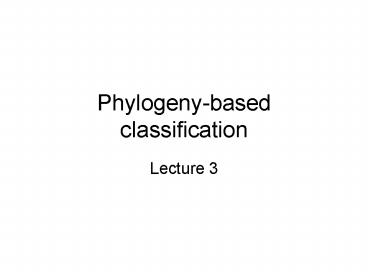Phylogenybased classification - PowerPoint PPT Presentation
1 / 15
Title:
Phylogenybased classification
Description:
Strict consensus trees only contain monophyletic groups common to all trees produced ... Monophyletic grouping are used in classifications b/c they are the ... – PowerPoint PPT presentation
Number of Views:64
Avg rating:3.0/5.0
Title: Phylogenybased classification
1
Phylogeny-based classification
- Lecture 3
2
Choosing trees
- Seems simple to determine the evolutionary
history of a group of organisms - Problems -homoplasy
- Parallelism appearance of similar character
states in unrelated organisms - Reversal derived character state changes back to
the ancestral state
3
Choosing trees
- Groups w/ 2 or more ancestral sources in which
parallel similarities have evolved are
polyphyletic - Makes it difficult to determine the order of
origin (p. 22) - How is one to determine which is the correct tree?
4
Choosing trees
- Occams razor do not generate a hypothesis any
more complex that is demanded by the data - Apply principle of parsimony
- Works well when evolutionary rates are relatively
slow enough that chance similarities
(independently derived) do not overwhelm
characters shared by the common ancestor - Minimum-distance method
- Based on minimizing dissimilarities
5
Choosing trees
- Maximum likelihood method
- Based on theories concerning probability of
change from one character state to another then
using the probabilities to calculate the
likelihood that a given diagram explains the data
observed - In reality there are many possible networks and
the answer is not obvious - Use programs to evaluate all possible trees
6
Summarizing evolutionary trees
- Systematists want to see what groups are found in
all of the shortest trees produced during
analysis - Consensus tree
- Strict consensus trees only contain monophyletic
groups common to all trees produced - Majority-rule tree show groups that appear in 50
or more of the trees
7
Which tree?
- The phylogenic tree is actually a model like
all models, assumptions are made - Mutation is random
- 11 relationship b/t gene and character
- How many genetic switches are involved?
- What is the possibility of a reversal?
- Are some characters harder to change than others?
- Weighting ex pubescence is likely easier to
change than leaf anatomy - Typically all characters are given equal weight
8
Constructing a classification
- Classifications communicate information
- Should be stable
- Multiple name changes make communication
difficult - Should be predictive
- Provide info about a plant
- Monophyletic grouping are used in classifications
b/c they are the result of evolution - More predictive and reflect genealogy
9
Constructing a classification
- Phylogenetic classifications can be used
- To search for
- Specific genes
- Biological products
- Biological control agents
- Potential crop species
- In conservation
- To provide a framework for bio knowledge
comparative studies
10
Constructing a classification
- 2 steps
- Delimitation naming of monophyletic groups
- Ranking the groups placing them in a hierarchy
- Herein lies the controversy which ranking is
correct??
11
Constructing a classification
- Cladistic classification only monophyletic groups
are named, not paraphyletic groups - Many exs of paraphyletic groups such as the
bryophytes (liverworts, hornworts, mosses) - bryophytes implies a close relationship, when
this is not the case - Not all monophyletic groups are named b/c it
would be cumbersome - Ex Liquidamber (sweetgum)
- Ex over ½ Poaceace is one large clade, but has
no formal name
12
Constructing a classification
- There really isnt any set criteria used to
decide which monophyletic groups should be named,
but the following criteria is generally used - Strength of evidence must be strong
- Should have a set of characters which distinguish
it (the clade) from other clades (diagnoses) - Must have an obvious morphological character
- For ex a field biologist (like me) doesnt care
cant use the fact that a clade is
characterized by an amino acid position in a
certain molecule BUT if it has a particular
morph. characteristic, then I do care b/c I can
diagnose the plant
13
Constructing a classification
- Also, group size is important for memorization
purposes - Ex liquidamber could be separated into 2 groups
ea. w/ 2 species ea., but why? - Finally, nomenclatural stability
- Remember its used for communication constant
name changes are a big pain
14
Ranking
- Biological classification is useful b/c those who
are not systematists can use the system - Botanical classification uses a system developed
in the 18th century (Linnaean ranks) - KPCOFGS
- This system can be used to express phylogenetic
relationships - Remember this is a construct
15
Ranking
- Also, recall that not all monophyletic groups are
named (p. 36) - Sequencing convention taxa forming an
asymmetrical part of a cladogram may be placed at
the same rank arranged in the order of
branching - Ex Poaceace (p. 36)































